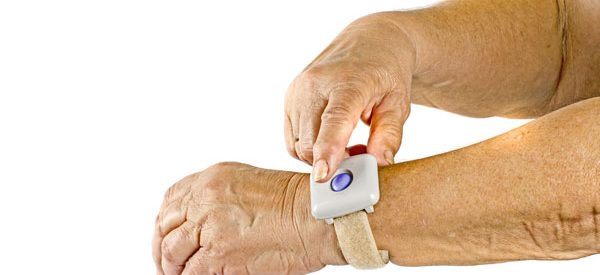
Personal Emergency Response Systems (PERS) help seniors and their families

Have you heard of Personal Emergency Response Systems (PERS)? They are also called other names including emergency panic buttons, fall detectors, and medical alert systems. They are designed to provide easy and immediate access to emergency services with one push of a button.
These devices are tremendously helpful and valuable to seniors and other at-risk individuals. How do they help seniors?
According to an infographic from Statistics Canada, 20% to 30% of seniors experience a fall every year, making falls the leading cause of injuries among elderly Canadians.
In the past, seniors were afraid of living alone in case they have a medical emergency and there would be nobody to help.
With a Personal Emergency Response System (PERS), seniors can always call for help by just pushing a panic button.
Learn more about how these advanced devices can help seniors and their families. You can also get FREE and NO-OBLIGATION quotes to save time and money.
The numerous benefits of Personal Emergency Response Systems (PERS)

Personal Emergency Response Systems (PERs) offer numerous benefits to seniors as well as their families.
Here are a few ways on how these devices enhance the quality of life of users and their caregivers.
#1: Increased independence.
Seniors with medical conditions can continue to live alone independently without worrying what to do in a medical emergency. Even healthy seniors who live alone don’t need to be checked on by family members frequently because they know the status of their loved ones is being monitored by qualified professionals.
#2: Greater confidence and peace of mind.
In addition, seniors can feel more confident about doing their routine tasks or being on their own because they have access to emergency support at any time.
Family members have peace of mind that their seniors are never really alone and can receive emergency assistance quickly when needed.
#3: Guaranteed emergency assistance.
Caregivers may not be able to be around to assist seniors 24/7 but a personal emergency response system is available round-the clock. Monitoring centers operate non-stop and can immediately respond when a user pushes the button. It is also equipped with 2-way voice communication to enable the user to speak to the monitoring center. The response time to an emergency is generally within 40 seconds, not minutes, which is critical in a medical emergency.
#4: Affordability
Most personal emergency response systems cost as little as $1 a day, the same amount you spend on a cup of coffee.
The cost can be easily justified when compared to the higher cost of round-the-clock home care.
#5: Ease of use
Many elderly persons are not tech-savvy and don’t want to use sophisticated or complicated systems. Most personal emergency response systems or panic buttons are very easy to use. They consist of wearable devices, usually in the form or a pendant or bracelet, that has an emergency button. It also has a 2-way speaker system that allows for quick communication by pressing the button.
#6: Waterproof and wearable.
Personal emergency systems or panic buttons are wearable devices that are lightweight and non-obtrusive. Seniors can wear them at all times, even to bed and the bath. Because they are always worn, seniors can press the panic button at any time without needing to use a phone. They are also waterproof and can be worn even in the shower where many accidents and falls happen.
As you can see, these devices offer numerous benefits that protect seniors. Immediate access to emergency services is critical, especially in life-threatening situations.
Make your loved one feel more confident and secure today! Give the best gift with a personal emergency response system.
Compare FREE and NO COMMITMENT quotes to shop for the right emergency panic button
for a parent or grandparent.
Just fill out the form on this page; it only takes 2 minutes.
How do Personal Emergency Response Systems (PERs) Work?

Greater advancements in mobile technology allow personal emergency response systems to provide protection even outside the home.
Depending on the type of system and monthly plan you choose, you can get emergency assistance even when you are on the go.
Many seniors and at-risk individuals still want to have an active lifestyle and be able to do routine tasks independently. When running errands, walking, or enjoying time out with friends, seniors can still feel confident and secure with mobile personal emergency response systems.
For active seniors, medical alert systems with fall detection and GPS technology are most beneficial.
While more expensive than standard home systems, mobile medical alert systems give seniors freedom and independence.
Personal Emergency Response Systems (PERs) are better than smartphones for seniors
Some people may say that smartphones can provide the same protection as personal emergency response systems. Unfortunately, this is not exactly true.
While a smartphone can give a senior some sense of security because they can connect with 911 or a family member, there may be issues on depending on a smartphone in a medical emergency.
For example, if you contact 911 from a smartphone, the emergency responders will not know immediately who you are or your location. Only your phone number shows on their screen. They can find out the nearest cell tower you are calling from but it won’t give them your exact location.
If the senior is unable to speak or provide details, it can delay the assistance needed and further complicate injuries.
Even if the cellphone has GPS, the details might not be relayed to a 911 dispatcher or relative.
Seniors with poor eyesight or unsteady hands may also find it difficult to use a smartphone in a medical emergency.
Lastly, it is not uncommon for people to forget to bring their smartphones with them when out on a walk or running an errand. PERs are worn on your person at all times, making them accessible in every type of emergency.
For these reasons, Personal Emergency Response Systems are better than smartphones for seniors.
Types of Personal Emergency Response Systems to Consider
When you have decided to get a personal emergency response system, the next step is to choose the system that matches your needs.
Most systems in the market are in the following categories:
Standard Personal Emergency Response Systems
Standard systems require the user to push a panic button when emergency help is required. There are two categories for this type of system.
- 2-way personal emergency response system with 24/7 monitoring services
- 2-way personal emergency response system without monitoring, calls 911 or a designated contact
Systems with monitoring are handled by a certified monitoring center with non-stop operations whereas unmonitored systems automatically dial 911 or a contact number.
Monitored systems have monthly monitoring fees and some providers may require a commitment period of 6 months, 24 months, or 36 months, depending on the company. Some systems offer extra protection features for greater security and peace of mind.
Unmonitored systems require a one-time fee for the device and has no monthly fees. However, take note that support from this type of system is limited and will greatly depend on the ability of contact numbers to receive emergency calls.
Fall detection systems
Systems with fall detection automatically alert a monitoring center in a possible fall. The technology uses acceleration of movement, unusual misalignments of the body, final position, and height to detect a fall. Advanced fall alert systems use many parameters to distinguish a fall from a normal movement.
This type of system is very useful for persons who are at risk for falls. They summon assistance even when the user is unable to push the panic button. They are waterproof and can be used inside the shower or toilet where many falls occur.
Personal emergency response systems with fall detection are a bit more expensive than standard systems but they can be valuable for seniors.
Systems with GPS tracking
Most wireless personal emergency response systems offer GPS tracking which provides protection outside the home. This allows a user to get help in any location with cellular signal.
This type of system is very useful for seniors with a risk of wandering. It can also be invaluable to any senior in case they get in trouble or need medical assistance and cannot provide their exact location. It also works in tandem with fall detection as it provides the monitoring center with the user’s location in the event of a fall.
Systems with medication reminders
Some systems also offer medication reminders for users with diabetes, hypertension, asthma, and other conditions. Many seniors forget to take their medications at the proper time. One of the usual tasks of caregivers is to ensure medication compliance.
This type of system can greatly reduce the burden of care and give seniors more independence while ensuring they avoid health complications
Reduce the cost of private home care with medical alert systems

In 2016, about 881,000 Canadian households had at least one member receiving private home care. These services allow people of various ages to receive assistance at home rather than at a facility or institution. While these services include nursing, physiotherapy, and help with tasks like meal preparation and bathing, others also take care of medications and companionship in case of an emergency.
Private home care can cost a lot of money, too. The cost can also be reduced partly by a medical alert system.
With a medical alert system, seniors can be left alone for a longer period of time without worry on the part of caregivers. The system lets them have access to emergency support at all times with a simple push of the panic button. The built-in speakerphone also lets them speak to a monitoring agent without having to get to a phone. Hence, this convenience allays the fear that the senior will be helpless if left alone.
You can consider a medical alert system to support the health care and support services received by a loved one. The cost is very reasonable at around $1 a day.
You can find out more about the cost of medical alert systems in Canada to help you in your choice.
FAQs on Personal Emergency Response Systems
When choosing a Personal Emergency Response System or medical alert system, you are sure to have a few questions in mind.
Below you will find useful information that can guide you in selecting the best system for your needs.
Are Personal Emergency Response Systems covered by health insurance?
Public and private insurance don’t usually cover the cost of personal emergency response systems. You can, however, verify this with your private insurer.
Do Personal Emergency Response systems require a landline?
Some of these providers offer only landline type systems but there are many that offer cellular or wireless systems, too. When shopping for a PERs, it is best to check their system requirements. If you don’t have a landline, go for a wireless or cellular system.
Do I need to sign a long-term contract to buy a Personal Emergency Response System?
Most of the reputable providers require a commitment such as 6 months, 24 months, or even 36 months, depending on the company. There are, however, companies that offer month-to-month contracts without cancelation fees. Check carefully before you choose a no-contract service and understand their prices and the quality of services offered.
Do I need fall detection?
Some people want more than just the standard protection from their personal emergency response system. Automatic fall detection is an extra layer of protection that is beneficial for individuals living alone and those with a history of falls. It is also highly recommended for individuals with medical conditions that put them at risk such as those with mobility issues, poor eyesight, balance issues, epilepsy, stroke, etc.
Are Personal Emergency Response Systems only for seniors?
No. While they were designed primarily for seniors, they are also useful for individuals who have medical conditions, recovering from an illness or surgery, and at-risk individuals.
How far does the system work?
The range of the system is measured from the base console. The range varies based on your provider and type of plan. Most home or landline-based systems have a range of 200, 300, or up to 600 ft. Other systems can have up to 1000 ft. Of course, wireless systems cover you everywhere you go as long as there is a cellular signal.
How does fall detection work?
Fall detectors use established parameters to distinguish a fall from a movement such as sitting or lying down. These include speed and acceleration, height, position, etc. Although the technology is not 100% reliable, it has a high degree of accuracy. It is very useful in a situation wherein a user falls and is unable to push the panic button or call on the phone. If the user is wearing the device, it will send an alert automatically to notify the monitoring center of a fall.
What happens if the senior does not push the button in an emergency?
Most standard systems require the user to push the button to receive assistance. Pushing the button connects the user immediately to a monitoring center where they can speak with an agent to ask for help. Systems with automatic fall detection will send an alert to a monitoring center even if the user does not push the button but only in a fall.
Are personal emergency response systems expensive?
You can find a personal emergency response system that costs as little as $1 a day. That isn’t really expensive as it costs about the same as a cup of ordinary coffee. The peace of mind and security you can get in exchange for this low amount is priceless.
What do you pay for when you buy a personal emergency response system?
The cost of a personal emergency response system varies from one company to another. With some providers, you pay a one-time fee for the equipment (the console and the wearable panic button), an activation or installation fee, and the monthly monitoring fees. For others, the device may be free or included in your monthly fees with just a one-time activation fee. It is best to compare multiple offers to find the right one that meets your needs.
Compare the price of Personal Emergency Response Systems for Seniors, Free of Charge!
According to the World Health Organization, 20% of falls occur between 9 pm and 7 am indicating that most falls occur at a time when they are likely alone.
Personal emergency response systems provide 24-hour monitoring, ensuring that someone will always be on hand to assist in any emergency.
Our reliable medical alert system partners offer wireless and home-based medical alert systems and personal emergency response systems to suit all types of needs.
Fill out the form below and receive FREE and NO COMMITMENT quotes to get the best value for your medical alert system.
Our partners offer only monitored medical alert systems that ensure you or your loved one will receive the HELP you need when you need it most.
Comments are closed.

Copyright© 2025 Compare Home Quotes.
Oolong Media






